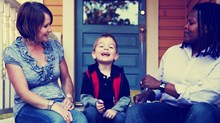Racial Identity and the Church

Each week we sat in a circle, huddled in a dorm room preparing our hearts for worship. For an entire semester our small group of diverse women gathered together to pray. One day a new face joined our little group. When it was time for her to pray, she started off shyly, carefully choosing each word. A voice within the group gently interrupted, “You know you can pray in any language you want.” We all felt her body shift as she exclaimed, “Really?” We opened our eyes and nodded in unison. As she switched from English to Spanish, the words burst from her small body, rushing together like a song. She sounded like an entirely different person. We only knew some phrases and key words, but that young woman lifted all of our hearts that night. By affirming her, we saw her true identity, and our view of God was expanded as we all imagined God whispering in Spanish back to her, back to us all.
Though she was praying in a language I didn’t know, there was something familiar about her worship. Attending a black church as a child, I remember being enthralled by hand-waving praise, melodious sermons, and gospel music that rose and fell with the emotions of the church. For two hours, we really were one body. Once our new group member was given the freedom to be herself, those memories and my own cultural background suddenly felt affirmed. An intense wave of belonging and connection took over. After that moment, we were never more committed to our group’s rule for cultural authenticity and cooperative participation. We all felt like we were home.
The Challenge Facing Multiracial Churches
When the Reverend Mihee Kim-Kort, minister and author of Yoked (with her husband Andy), considers her faith formation, she effortlessly recalls her childhood Korean-American church: “Every Sunday was full. We would get up early in the morning, usually hauling containers of food to donate to the church. The 20-minute drive was a little sleepy, but as soon as we stepped foot through the church doors and saw other families, we stirred and started to run and play with the other children. Adults would yell at us to slow down, or tell us to insa—respectfully greet—the elders and deacons of the church, pinch our cheeks, and say how fast we were growing up.”
Connecting treasured memories to the present, she continues: “When I think back to it, now I remember how clear it was that something different happened to my parents on Sundays. I saw the tension melt from their faces as they settled into the pews and chairs. I saw the comfort and familiarity in which they carried conversations like a burden being lifted from their shoulders. I saw the way they laughed easily, and happily talked and shared with other church members. My parents and I immigrated to the U.S. from South Korea when I was just a baby, so this church was a slice of home for them.”
It seems the “slice of home” Kim-Kort describes is in danger of being severely restricted when we move out of mono-cultural spaces. If you follow reports on popular church trends, you’ve probably noticed an increase in conversations about multiracial churches. Most regularly defined as a congregation in which the majority racial group is no more than 80 percent of the population, the number of multiracial congregations (and those seeking to be multiracial) is on the rise.
As the number of studies, books, and articles proliferate on the subject, we’ve been able to take a peek into how multiracial churches operate. Sociologists have found that often, multiracial churches choose to avoid conversations regarding race. By seeking to transcend race, multiracial churches attempt to avoid cultural conflicts that might not otherwise arise in homogenous churches. But whether homogenous or multiracial, what do we lose by not actively engaging our racial and ethnic identities?
Embracing Our Differences, Offering Our Gifts
Daniel Hill, the pastor of River City Community Church in Chicago, Ilinois, and author of 10:10: Life to the Fullest, warns that by avoiding the conversation we risk missing the fullness of who we are in God. “Core to the doctrine of the imago dei [image of God] is that we are all reflections of God’s good design,” he says, “and that we are to, therefore, live as redeemed, beloved sons and daughters who carry a deep sense of that divine identity. Race and culture aren’t the only parts to that identity, but they are huge facets. Learning to embrace and affirm our racial location and cultural identity therefore becomes a big part of living into the imago dei.”
Offering us a practical example, the Reverend Dr. Brenda Salter McNeil, professor of Reconciliation Studies at Seattle Pacific University and associate pastor at Quest Church adds, “I am not expected to be anyone else when I stand up to teach. I always ask the congregation to engage with me in a different way than they would engage others on the teaching team. I can request that people shout amen or that they lift their hands when we pray. I can be my full self! It’s understood that being different is not an attempt to make people uncomfortable. Room is made for me to be myself. My gift for peaching is significantly more powerful when I am free to be who God made me.”
Zooming out with a wider lens, she surmises: “This is a gift not just for me but for all of our leaders [to be themselves]. We have to give space for people to operate in their gifts in culturally nuanced ways. How incredible is it when we have an opportunity to worship God through various languages, spoken word, rap, dance, or various music genres? These are all culturally located, as is preaching, and they add to our experience of one another and God.”
Cultural Identity and the Mission of God
Drawing on Scripture, Hill reminds us of how important ethnic identity is in Scripture, “If we had time, we could go through the stories of Joseph, Moses, Daniel, Esther, Peter, Paul, and Timothy (and others) and point to how central the affirmation of cultural identity was both to their own transformation and their ability to join the mission of God. We find then that racial identity is integral to discipleship as we learn to embrace our God-given identity and as we embark upon a Spirit-led life of mission.”
Without hesitation, Kim-Kort speaks quite intimately as she expresses the connection between her identity, faith formation, and mission: “Even now as I continue in my vocational journey while challenging the larger institutional church to engage issues of racism and sexism, I’m hopeful my stories matter. My stories are a part of other stories throughout history—stories about immigration, marginalization, survival, and resistance. They are part of what makes the church true and real each day because it is the particular that gives us glimpses of the universal. The church calls us to courageously share our slices for the sake of the whole kingdom.”
All three of these leaders are clear that the beauty that arises from engaging racial identity far outweighs the risk of conflict. An attempt to transcend the ways we are different restricts our experience of God. By digging into our racial identities, we give ourselves the greatest chance for affirming our place in the imago dei. This is no exercise in narcissism but rather a step toward closer connection with one another, a step nearer to reconciliation. For when we are all welcome to offer our authentic voices in worship to the God who created us all, we are sure to find home.
Austin Channing Brown is a TCW regular contributor. A resident director and multicultural liaison at Calvin College, Austin is passionate about racial reconciliation—and has a slight obsession with books. When she’s not reading, you’ll find Austin watching HGTV or updating her blog AustinChanning.com.
Read more articles that highlight writing by Christian women at ChristianityToday.com/Women
 Read These Next
Read These Next

 Online Dating Isn't for MeChoosing to be the real me in a world of dating profiles
Online Dating Isn't for MeChoosing to be the real me in a world of dating profiles How Great a Father's LoveIt even extends to our hair
How Great a Father's LoveIt even extends to our hair
 Imago GayThe key to truly loving your neighbors, whether they’re gay, straight, or anything in between
Imago GayThe key to truly loving your neighbors, whether they’re gay, straight, or anything in between








 Homepage
Homepage
